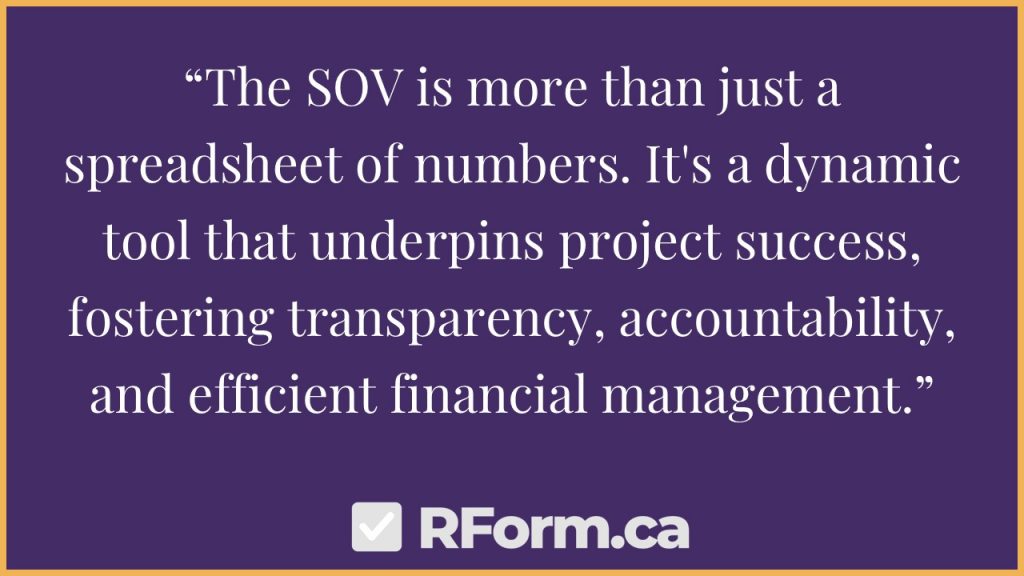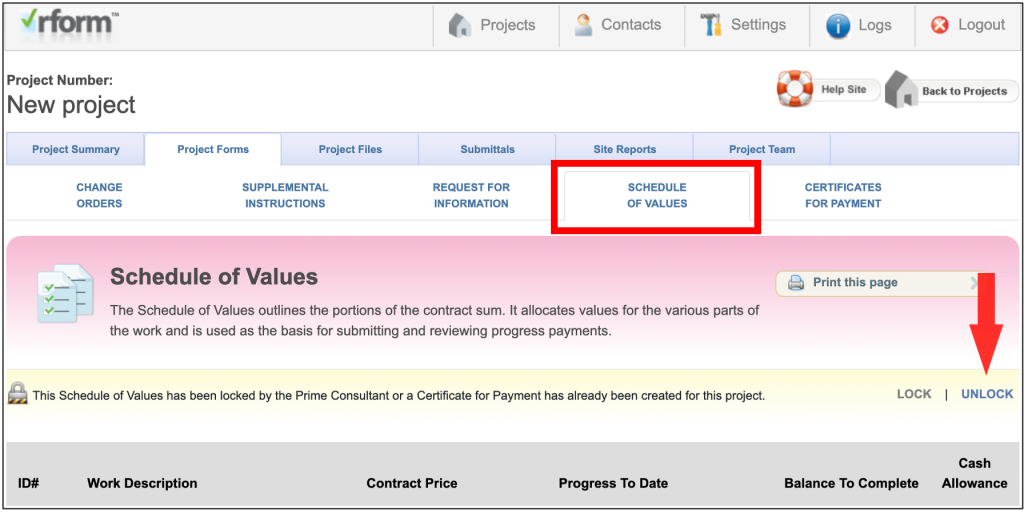
In the pre-construction phase of a project, it’s crucial to set the stage for success. This includes a site visit, creating a schedule of values (SOV), and forming the construction team. The SOV is a key document that outlines each work item’s cost and tracks the project’s progress to ensure it stays within budget.
Key Points to Consider
- The contractor must submit the SOV to the consultant at least 15 calendar days before the first payment application.
- The SOV should include the total contract price to facilitate payment application evaluation.
- The consultant can direct the SOV’s format and supporting evidence.
- The accepted SOV becomes the basis for payment applications unless errors are found.
Completing these pre-construction activities, including having a complete SOV, helps ensure your project’s success. It also forms the baseline for the contract, providing a clear understanding of the project’s scope and budget for all stakeholders.
Why a Schedule of Values is Your Key to Success
Where budgets, timelines, and many stakeholders intertwine, the Schedule of Values (SOV) is often overlooked or underestimated. The SOV is more than just a spreadsheet of numbers. It’s a dynamic tool that underpins project success, fostering transparency, accountability, and efficient financial management. Whether you’re a seasoned contractor or a project owner embarking on your first construction venture, understanding the power of the SOV is essential for navigating the complexities of the building process.
Deconstructing the Schedule of Values
At its core, the SOV is a detailed breakdown of all the work involved in a construction project, organized into discrete line items with their associated costs. Think of it as an itemized receipt for your entire project, where each task, material, and labor component is clearly defined and valued. When summed up, these individual values equate to the total contract value.
But the SOV is much more than just a static cost breakdown. It’s a living document that evolves with the project, tracking progress, facilitating payments, and providing a framework for managing change orders.
Why is the SOV so Important?
The SOV is a cornerstone of successful construction projects for several reasons:
- Transparency and Accountability: It provides a clear and concise picture of where every dollar is spent, fostering trust and open communication between project owners and contractors.
- Progress Tracking: By linking payments to completed work items, the SOV enables accurate monitoring of project progress and identification of potential delays or cost overruns.
- Payment Management: It forms the basis for progress payments, ensuring contractors are paid fairly for the work they’ve completed and mitigating payment disputes.
- Change Order Management: When changes arise, the SOV provides a framework for evaluating and pricing those changes, maintaining budget control even in dynamic project environments.
Benefits for Project Owners
For project owners, the SOV is an invaluable tool for maintaining control and oversight of their investment. It empowers them to:
- Understand Project Costs: The SOV provides a granular view of the allocation of the total contract value across different work items, facilitating informed decision-making.
- Ensure Fair Payment Practices: By clearly defining the value of each work item, the SOV enables owners to make payments based on the percentage of work completed, promoting fairness and transparency.
- Monitor Project Progress: The SOV allows owners to track the project’s progress against the planned schedule, identify potential delays, and take proactive measures to mitigate risks.
Benefits for Contractors
Contractors also reap significant benefits from a well-crafted SOV:
- Efficient Project Management: The SOV serves as a roadmap for the project, guiding resource allocation, scheduling, and overall execution.
- Financial Stability: It provides a predictable payment schedule, ensuring consistent cash flow throughout the project lifecycle.
- Improved Communication: The SOV fosters clear communication with the owner and other stakeholders, reducing the likelihood of misunderstandings and disputes.
Building a Comprehensive Schedule of Values
While the specific format and level of detail may vary, a comprehensive SOV should include:
- Detailed Work Items: A clear description of each task or scope of work.
- Values for Each Item: Accurate cost estimates for each work item, including labor, materials, and equipment.
- Percentage of Completion: A mechanism for tracking the progress of each work item.
- Remaining Balances: The outstanding value for each line item.
- Retainage: Clearly defined retainage percentages for each work item.
- Contingencies and Allowances: Line items for any contingencies or allowances included in the contract.
Best Practices for Creating Effective SOVs
To maximize the benefits of your SOV, consider these best practices:
- Mirror Contract Documents: Align line items with the project specifications and contract documents to ensure consistency and avoid discrepancies.
- Integrate with the Project Schedule: Link SOV line items to tasks in the project schedule to enable accurate progress tracking and cash flow forecasting.
- Use a Standardized Template: Employ a standardized template with built-in formulas to streamline updates and maintain accuracy.
- Include All Expenses: Account for all project expenses, including labor, materials, equipment, and subcontractor costs.
- Provide Sufficient Detail: Ensure enough detail is included to facilitate timely work approval and progress payments.
- Regularly Update: Keep the SOV updated throughout the project to reflect actual progress and any changes to the scope of work.
The SOV and Cash Flow Management
While not a cash flow management tool, the SOV facilitates timely payments and maintains financial stability. By providing a clear framework for progress billing, the SOV helps contractors secure consistent cash flow and avoid payment delays.
A well-structured SOV can be particularly beneficial for subcontractors in ensuring prompt payment from general contractors. It provides a transparent record of completed work and associated costs, reducing the risk of payment disputes and ensuring fair compensation.
The SOV as a Risk Management Tool
Beyond its financial benefits, the SOV is a valuable risk management tool. A detailed breakdown of project costs and progress enables early identification of potential issues, such as cost overruns or schedule delays. This allows for proactive intervention and mitigation, minimizing the impact of these risks on the project’s overall success.
More information about the Schedule of Values on the RForm Feature Page
Conclusion
The Schedule of Values is an indispensable tool for construction projects. It’s a roadmap for success, guiding financial management, progress tracking, and communication throughout the project lifecycle. By embracing the SOV and implementing best practices for its creation and management, project owners and contractors can unlock greater transparency, efficiency, and control, paving the way for successful project outcomes.


